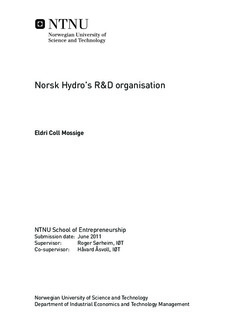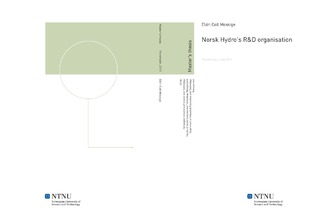| dc.description.abstract | The problem definition for this master thesis is formulated in collaboration with Hydro representatives, and is related to Hydro s CROC project. The thesis aims to critically review Hydro s R&D organisation, and reveal factors which hinder synergies from being realised, and innovation to take place. A proposal for improvement has also been prepared.A broad literature study on the topic Radical innovation in mature organisations provides the theoretical foundation for the perspective of this master thesis. The study focuses on the problems of large and mature organisations in promoting and responding to radical innovation in their industries. The concepts of Dynamic Capabilities and Absorptive Capacity are particularly focused upon, and the study emphasises resource-based theories for strategy with an inside-out perspective. Four case studies have been carried out in Hydro s mid- and downstream R&D organisation. Empirical data has been collected through interviews and meetings; six interviewees in Hydro s R&D management have provided rich data for analysis. Main themes include cross-sectional cooperation, innovation challenges, cultural differences and structural assets within the R&D organisation. Hydro s R&D organisation employs a polycentric, decentralised model, and is characterised by high centre autonomy and unrealised synergies. The organisational structure bears evidence of a history of acquisitions. Building Systems R&D department and Upstream R&D are omitted from the central R&D organisation for no evident reason. The remaining R&D organisation serves all of Hydro s business areas, however, mid- and downstream R&D is line organised under one single business sector. This leads to problems at top level, as the head of R&D reports to the representative of one business sector, although personally representing an organisation which serves the entire value chain. The R&D centres are tightly connected to their internal clients, which operate within distinct business sectors. The clients have strategic power as a result of financial power over R&D, and are free to define projects as they wish. There are few multisite R&D projects, and in all, little collaboration between the centres. Competence overlap is evident between some sites. Silo mentality is present at all sites, and is evident both between and within the R&D centres. There is little common culture and identity marking the R&D organisation, and this complicates internal collaboration. Limited internal collaboration leads to a weak social capital, in turn making the organisation less flexible when faced with the challenges represented by a radical change in the environment. Strong customer dedication along with strict key performance indicators and reward systems, leads to short term focus. Routines for Technology Watch are absent; technology watch happens sporadically and randomly. The strategic focus on Step Change (radical) innovation in Hydro is not translated into practice in the organisation. Processes for facilitating innovation projects are lacking, and although the New Ideas programme functions relatively well, there is a lack of follow-up on the New Ideas projects. The organisation relies heavily on individuals initiative to promote innovation. My proposal involves three main changes, which are listed below.1. Gathering of all R&D activities in one central R&D organisation. The head of the R&D organisation should report directly to the Group Chief Executive and be seated in corporate management.2. Financial empowerment of the R&D organisation. More projects should be financed by the central R&D organisation, allowing a more long-term approach and focus on step change projects. 3. Establishment of a hub for innovation; responsible for taking care of Hydro s efforts to create step change. The hub is a transversal organisational entity, employing key people from every business sector and every R&D centre.If executed properly, these structural and formal changes may significantly enhance the organisation s internal social capital and rate of collaboration, as they provide a fresh foundation on which a uniform creative R&D culture and identity can be built. This will stimulate a realisation of latent synergies in the organisation and improved R&D performance. A unifying and creative culture also makes the workforce more flexible and their behaviours more predictable, which positively affects the dynamic capabilities of the organisation. The hub takes on responsibility for technology watch and screening and selection of innovation projects, directly improving the absorptive capacity and innovation processes in Hydro s R&D organisation. Combined with a creative culture, this makes the organisation more prone to promoting step change innovation.The proposed changes may help direct Hydro s R&D organisation towards the integrated R&D network model. | nb_NO |

